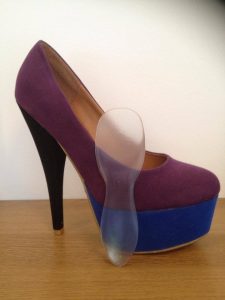How to Prevent & Treat Heel Pain
How do I prevent it?
Follow the self-care measures below in the first instance.
What are the treatments?
If you experience heel pain, some simple self-care measures include:
- Avoid wearing ill-fitting or uncomfortable shoes
- Wear shoes with good heel cushioning and effective arch support
- Avoid walking or exercising on hard ground
- Rest regularly and try not to walk or run too fast
- Wear a raised heel (no more than 6-10 mm higher than normal)
- Lose weight if you are overweight
More specialist treatments include:
Heel spurs (plantar fasciitis or fasciosis):

Treatment can take many forms from resting your foot as much as possible, stretching exercises and deep heat therapy to steroid injections and even medication or surgery to release the tight tissue ‘band’. In some cases, padding and strapping is applied to alter the direction of stretch of the ligament to alleviate symptoms in the short-term. However, for the long-term, special insoles (orthoses) are prescribed to help the feet to function more effectively and help to make any possible recurrence less likely.
Heel bursitis (calcaneal bursitis):
Medication and ultrasound can give relief but for the long-term, a shoe insert may be necessary. In addition, attention to the cause of any rubbing and appropriate padding and strapping will allow inflammation to settle.
Heel bumps:
Adjustments to footwear is usually enough to make them comfortable, although a leather heel counter and wearing boots may help. In more serious, recurring cases, surgery may be necessary.
Tarsal tunnel syndrome:
Special shoe inserts can reduce the pressures on the nerve and may be appropriate for certain foot types whereas, on other occasions, local injections of medication to the area where the tibial nerve is inflamed may be necessary.
Chronic inflammation of the heel pad:
A soft heel cushion can help this condition.
Stress fracture:
If this is suspected, an X-ray is required to confirm final diagnosis and to determine the extent of the injury and a follow-on treatment plan.
Severs disease (osteochondrosis):
This condition is temporary and self-limiting but can be painful at the time.
Achilles Tendonosis:
Treatment involves special exercises that strengthen the tendon and increasing the height of the heel with an insole on a temporary basis.
When should I see a podiatrist about it?
To talk to a podiatrist (also known as a chiropodist) about the options available regarding treatment, you can contact an NHS podiatrist or a private practice podiatrist. In both cases, always ensure that any practitioners you visit are registered with the Health Professionals Council (HPC) and describe themselves as a podiatrist (or chiropodist).
Find out more about The Causes of Heel Pain.

